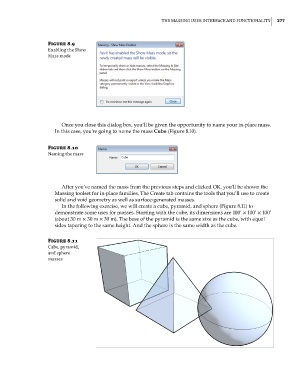Page 311 - Divyank Tyagi
P. 311
|
The MAssing User inTerfAce And fUncTionAliTy 277
Figure 8.9
enabling the show
Mass mode
Once you close this dialog box, you’ll be given the opportunity to name your in-place mass.
In this case, you’re going to name the mass Cube (Figure 8.10).
Figure 8.10
naming the mass
After you’ve named the mass from the previous steps and clicked OK, you’ll be shown the
Massing toolset for in-place families. The Create tab contains the tools that you’ll use to create
solid and void geometry as well as surface-generated masses.
In the following exercise, we will create a cube, pyramid, and sphere (Figure 8.11) to
demonstrate some uses for masses. Starting with the cube, its dimensions are 100’ × 100’ × 100’
(about 30 m × 30 m × 30 m). The base of the pyramid is the same size as the cube, with equal
sides tapering to the same height. And the sphere is the same width as the cube.
Figure 8.11
cube, pyramid,
and sphere
masses
c08.indd 277 05-05-2014 16:47:30

